
The Dan Armstrong effects units were being produced in England by Wareham until 1977 as well as in the US by
Musitronics from 1976 to 1978 and from Beigel Sound Labs from 1980 to 1984. They were
also produced overseas shortly after Musitronics closed their doors. Craig Buzzart goes on to say "After Mutron
folded Joichi Yui (of the original Schecter Guitars and I had the Dan Armstrong effects boxes made in
Japan for a short time by the same manufacturer that made the Ibanez TS-808 Tube Screamer units" [Maxon]
"I wish I had one of those pedals as they were very well made, and are very rare."
Although the units sold well for a few more years by the late 1970s things soon began to slow down and before the
decade was out Wareham had ceased production. Years later Dan's son Kent acquired the registered trademark of the
Dan Armstrong sound modifier units with all rights and privileges and he began to produce the Dan Armstrong effects
himself.
Kent Armstrong states "when something is out of production for seven years the ownership of the trademark expires.
At that point, anyone in the world can acquire the trademark and do whatever they want with it. They can sit on it,
resell it, or use it. For example, WD Electronics is now the holder of the Stromburst instrument trademark as the latter had let it expire."
Kent continues, adding "when Wareham Electronics fell apart in the late 1970's - Dan owed them a lot of money so I
paid off the debts, and bought all the left over bankrupt stock as well as the remaining production parts in an attempt
to reintroduce the effects pedals that were laying in limbo." When asked why he bothered to remake Dan's pedals,
Kent stated "well, first off they are just very good sounding pedals, and I knew that they would sell pretty well.
Secondly, I wanted a chance to recoup the financial losses that I had incurred when I worked at the factory making the
Dan Armstrong 'London' instruments a few years prior." In an effort to help his father, and keep the factory
running, Kent had apparently been working with no compensation for some time.
Although Kent was legally within the law, and despite the fact that he had actually paid off a great deal of his
fathers debt - Dan was furious at him for taking such matters into his own hands. It would not be the first time that
the two would not see eye-to-eye and unfortunately, it would lead them to not speaking to one another for many years.
The first time was in 1977 when Kent tried to recoup the aforementioned financial losses by suggesting to his father
that together they reproduce the pickups that Dan and Bill Lawrence made for the Ampeg acrylic instruments as by this
point in time guitarists from all walks of life were seeking the various 'other' pickup models that the clear
instruments supported but did not ship with.
The proposal was for Kent to manufacture and distribute the pickups, and for using his fathers name they would split
the proceeds. Unfortunately it didn't work out - for Dan wanted an additional 10% above of the proceeds for the use of
his name. Kent goes on to describe "It just didn't seem right to me. I would have been doing all the work and Dan
would get as much - actually more for just using his name. It felt wrong and so I told him that I wasn't interested."
Kent then went on to make his own pickups using the name 'Rainbow Pickups' and once his name was more established, he
changed it to Kent Armstrong
Pickups. Unfortunately for many years these sorely needed pickups - made by Dan Armstrong & son never materalized.
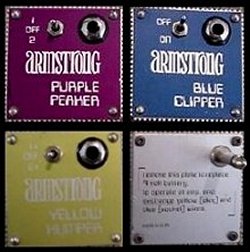
|
The Dan Armstrong effects were made with original parts and left over stock, so they looked and sounded just like the
original Wareham units. However, before long some of the original stock parts were used up. One of the first such parts
to be exhausted was the actual various colored top pieces that houses the input jack and mini toggle switch.
Kent Armstrong goes on to say "After that, the units just had the name Armstrong on them." As can be seen at
left, are a few of these effects. Upon seeing the 'Armstrong' effects pedals once again being made, WD Electronics took
interest in the line and by 1990 had contacted and contracted Kent to eventually produce the effects for them.
|
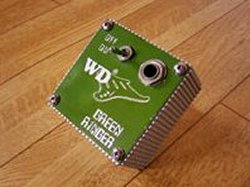
|
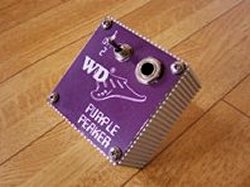
|
As can be seen above left & right, the effects units would retain their former names as well as their particular
and respective sound effect but the name on the top plates would now change. Naturally, WD choose instead to
put their business logo on the unit along with a decal of a Stratocaster scratchplate. Notice how
the boxes retain the look of the Wareham units with more interlocking tabs than the Musitronics units.
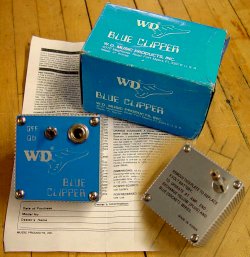
|
Soon afterwards, WD Electronics wanted to build cheaper versions of the effects units. Since Kent was busy making
his own pickups anyway, it was agreed to have the units made in a facility in Korea.
As seen at left, the units came with virtually the same literature as the original units along with the same type of
cardboard box, though these were different in that the boxes shared the same color coding as the unit that was
packaged within.
The made in Korea stamp is clearly visible on this Blue Clipper in the enlarged view on both the unit
itself, as well as on the outside of the box.
|
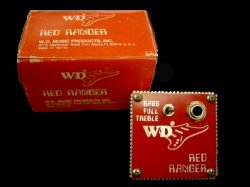
|
As seen at left, a WD Red Ranger. This one, like the Blue Clipper above is made in Korea. Notice the
matching color coded box that it shipped in. In this photo the colored box takes on more of an orange tint to it but
that may be due to it's age, or perhaps the lighting.
Again notice the additional interlocking tabs over that on the Musitronics units - making these effects more like the
original Wareham units.
|
As seen above. Sometime in the early 1990's Dan designed a newer, type of compressor/sustainer that he
called the Super Squeezer. Basically it is the Orange Crusher with a few modifications and the
literature that accompanies it states that it is "a 1990's version of the original compressor circuit for electric
guitar and bass which he made so popular in the mid to late 1970's."
Unlike the version before it, this unit was mounted inside the guitar control cavity and would call for a mini-toggle
switch to be installed on the instrument. Like the earlier units however, this on board circuitry utilized a 9 volt
battery - and the battery would then reside inside the guitars control cavity along with everything else. Care would
have to be taken to secure the battery down to keep it from shorting to any of the guitars circuitry.
The literature that accompanies these units also mention that "Power consumption has been reduced by a factor of 100
while the circuit gain has increased fourfold." These units were produced and marketed through the
Starr Switch Company
of San Diego, CA. which is still selling this unit, although their name has since changed to
Starr Labs. As seen at right, notice the reference
to the Orange Squeezer as their circuit board sits atop a cluster of oranges which acts as a backdrop for their packaging
back then.
continue
menu
Names and images are TMand © Dan Armstrong / Ampeg. All rights reserved.
All other names and images are TMand © of their respective owners. All rights reserved.
|
| |

